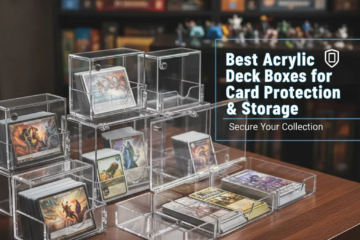Whether you’re a trading card game enthusiast, a sports card collector, or someone who enjoys showcasing your favorite collectible cards, one thing is certain — protecting your cards is essential. Card sleeves act as the first line of defense against dust, scratches, fingerprints, and accidental spills. However, many collectors overlook a crucial aspect: how to properly apply card sleeves to a deck.
In this comprehensive guide, we’ll walk you through the correct way to sleeve your cards, ensuring they stay in pristine condition while maintaining a professional, organized appearance. This guide is designed for collectors and players across the United States, covering everything from sleeve types to best practices for sleeving and storage.
Why Card Sleeves Matter
Before diving into the application process, it’s important to understand why sleeving matters. Card sleeves are not just accessories — they’re protective investments. Whether you’re sleeving Pokémon, Magic: The Gathering (MTG), Yu-Gi-Oh!, or baseball cards, sleeves:
Preserve Value: Prevent scratches, dents, and fading that can reduce resale or trade value.
Prevent Moisture Damage: Shield against humidity, spills, or sweat from hands.
Improve Handling: Allow for smoother shuffling and reduce corner bending.
Enhance Appearance: Provide a uniform, sleek look for both casual and professional play.
If you plan to attend tournaments, trade shows, or simply want your cards to remain mint, properly applying sleeves is the foundation of long-term card care.
Step 1: Choose the Right Type of Card Sleeves
The first and most critical step in sleeving your deck is choosing the right type of sleeves. Not all sleeves are created equal — different cards and playstyles demand different materials and fits. Below are the most common sleeve types used in the U.S. market.
1. Penny Sleeves (Soft Sleeves)
Best For: Short-term storage or double-sleeving.
Material: Polypropylene or polyethylene.
Pros: Affordable, crystal-clear, and thin.
Cons: Easily tear if overused; not suitable for gameplay.
These are great for budget-conscious collectors who want to protect bulk cards or for use as the first layer in a double-sleeve setup.
2. Standard Deck Sleeves (Matte or Glossy Finish)
Best For: Everyday play or trade decks.
Material: Durable plastic with a textured or smooth back.
Pros: Comfortable for shuffling, reduces glare.
Cons: May slightly wear after extensive play.
These are the go-to sleeves for MTG and Pokémon players in the U.S.
3. Perfect Fit or Inner Sleeves
Best For: Double-sleeving high-value cards.
Design: Snug, form-fitting sleeves that go inside another sleeve.
Pros: Creates a waterproof seal when combined with outer sleeves.
Cons: Can be difficult to insert without practice.
4. Tournament Sleeves
Best For: Competitive play and graded decks.
Material: Thicker and more resistant plastic.
Pros: Long-lasting, elegant look, and tournament-approved.
Cons: Slightly more expensive.
Once you’ve selected the right type, it’s time to move on to preparation.
Step 2: Prepare Your Workspace
Before sleeving your cards, cleanliness and organization are essential. Even the smallest particle of dust can cause micro-scratches or air bubbles when inserting cards into sleeves.
Here’s what you should do:
- Wash and Dry Your Hands: Avoid oils or dirt transferring to the cards.
- Clean Surface: Use a lint-free cloth to wipe the table or desk.
- Stack Cards Neatly: Keep your deck in the order you want it sleeved.
- Check Lighting: Good lighting ensures no debris enters the sleeves unnoticed.
Preparation ensures that your cards and sleeves remain dust-free during the entire process.
Step 3: Insert the Cards Correctly
Now comes the most delicate step — inserting the cards into sleeves. Doing this correctly prevents damage and ensures a perfect fit.
Option 1: Single Sleeving
If you’re using only one sleeve per card (common for casual players), follow these steps:
- Hold the Card by Its Edges: Never touch the front or back surface.
- Open the Sleeve Gently: Use your thumb and index finger to create space.
- Slide the Card in Slowly: Insert from the top, letting gravity do the work.
- Smooth Out Air Bubbles: Tap gently on a soft surface to flatten.
Option 2: Double Sleeving
Double sleeving provides the highest level of protection, particularly for rare or valuable cards.
- First Sleeve (Perfect Fit): Insert the card upside-down (opening at the bottom).
- Second Sleeve (Outer): Insert the card right-side-up into the standard sleeve.
- Result: The two openings face opposite directions, forming a tight seal that blocks out dust and liquids.
This method is ideal for competitive TCG players and collectors who want museum-grade preservation.
Step 4: Organize and Align Your Deck
After sleeving each card, you’ll want your deck to look uniform and feel comfortable to shuffle.
Check Orientation: Ensure all sleeves face the same direction to prevent friction.
Tap Deck Edges: Gently tap the deck on a soft surface to align the corners.
Use Deck Boxes: Store the sleeved deck in a properly sized box to prevent bending.
Uniform sleeving also ensures smoother gameplay, especially during shuffling and dealing.
Step 5: Maintain and Replace Sleeves Periodically
Even the best sleeves wear out over time. Regular maintenance keeps your collection safe and looking its best.
Tips for Sleeve Maintenance:
Rotate Decks: Avoid using the same deck sleeves for every game.
Replace Worn Sleeves: Look for scratches, cloudiness, or corner peeling.
Store in a Cool, Dry Place: Heat and humidity can warp sleeves.
Avoid Stacking Heavy Items: This prevents pressure marks on cards.
For long-term storage of rare cards, consider double-sleeving plus hard toploaders or magnetic cases for maximum protection.
Step 6: Avoid Common Mistakes When Applying Card Sleeves
Even experienced players make simple mistakes that can harm their cards. Here are the top ones to avoid:
- Forcing Cards In: If a card doesn’t slide easily, stop and realign.
- Touching Surfaces: Fingerprints can permanently damage holographic finishes.
- Skipping the Cleaning Step: Dust and dirt can scratch your cards during insertion.
- Using Poor-Quality Sleeves: Cheap sleeves can split or yellow over time.
- Inconsistent Sleeve Directions: This can cause friction and edge wear.
Being patient and methodical while sleeving your deck saves you from costly mistakes later.
Step 7: Store and Transport Your Sleeved Deck Safely
Proper storage is as important as sleeving itself. Whether you’re heading to a local card shop in California or attending a TCG tournament in New York, protecting your deck on the move is crucial.
Recommended Practices:
Use Deck Boxes with Padding: Choose a box slightly larger than your sleeved deck.
Add Silica Gel Packs: Keeps moisture away from cards.
Avoid Direct Sunlight: UV rays can fade cards and sleeves alike.
Label Decks Clearly: Helps organize different builds or collections.
Your sleeved cards deserve the same care in storage as they do during use.
Step 8: Double-Sleeving Alternatives
For ultra-valuable cards such as first-edition Pokémon, vintage baseball cards, or rare MTG foils, you might want to go beyond sleeving.
Additional Protection Options:
Toploaders: Rigid plastic holders ideal for individual display cards.
Card Savers: Flexible semi-rigid sleeves commonly used for PSA grading.
Magnetic One-Touch Cases: Perfect for premium cards where presentation matters.
Combining these options with proper sleeves offers museum-level preservation for your prized collectibles.
Conclusion
Applying card sleeves correctly is more than a simple process — it’s a craft that blends protection, precision, and presentation. Whether you’re safeguarding a casual deck or curating a rare collection, the right sleeves and techniques will ensure your cards remain in flawless condition for years to come.
For collectors and players across the U.S. seeking premium-quality card sleeves that combine durability, aesthetic appeal, and professional-grade protection, explore Prismatic Defender. Their expertly crafted sleeves are designed to fit perfectly, offering both clarity and strength — trusted by collectors who value quality and care above all else.


